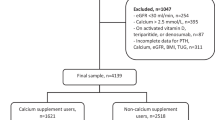Abstract
The bioequivalence and pharmacokinetics of alendronate sodium tablets were examined by determining the plasma concentration of alendronate. Two groups, consisting of 24 healthy volunteers, each received a 70 mg reference alendronate sodium tablet and a test tablet in a 2×2 crossover study. There was a 6-day washout period between doses. The plasma alendronate concentration was monitored for 7 h after the dose, using HPLC-Fluorescence Detector (FD). The area under the plasma, concentration-time curve from time 0 to the last sampling time at 7 h (AUC0-7h) was calculated using the linear-log trapezoidal rule. The maximum plasma drug concentration (Cmax) and the time to reach Cmax (Tmax) were derived from the transformed AUC0-7h and Cmax, and untransformed Tmax. For the test medication versus the reference medication, the AUC0-7h were 87.63±29.27 vs. 102.44±69.96 ng·h·mL−1 and the Cmax values were 34.29±13.77 vs. 38.47±24.39 ng·mL−1, respectively. The 90% confidence intervals of the mean differences of the logarithmic transformed AUC0-7h and Cmax values were log 0.8234-log 1.1597 and log 0.8222-log 1.1409, respectively, satisfying the bioequivalence criteria guidelines of both the US Food and Drug Administration and the Korea Food and Drug Administration. The other pharmacokinetic parameters for the test drug versus reference drug, respectively, were: t1/2, 1.87±0.62 vs 1.77±0.54 h; V/F, 2061.30±986.49 vs. 2576.45±1826.05 L; CL/F, 835.32±35 vs. 889.48±485.87 L·h−1; Kel, 0.42±0.14 vs 0.40±0.18 h−1; Ka, 4.46±3.63 vs. 3.80±3.64 h−1; and Tlag, 0.19±0.09 vs. 0.18±0.06 h. These results indicated that two alendronate formulations (70-mg alendronate sodium) were biologically equivalent and can be prescribed interchangeably.
Similar content being viewed by others
References
Astrom, E. and Soderhall S., Beneficial effect of bisphosphonate during five years of treatment of severe osteogenesis imperfecta.Acta. Paediatr., 87, 64–68 (1998).
Kang, W. K., Yun, H. Y., and Kwon, K. I., Assessing the bioequivalence of 4- and 8-mg benidipine tablets in healthy volunteers after a single oral dose.J. Clin. Pharm. Ther., 30, 85–90 (2005).
Lane, J. M., Khan, S. N., O'Connor, W. J., Nydick, M., Hommen, J. P., and Schneider, R., Bisphosphonate therapy in fibrous dysplasia. Clin. Orthop., 6–12 (2001).
Liberman, U. A., Weiss, S. R., Broll, J., Minne, H. W., Quan, H., and Bell, N. H., Effect of oral alendronate on, bone mineral density and the incidence of fractures in postmenopausal osteoporosis.N. Engl. J. Med., 333, 1437–1443 (1995).
Lin, J. H., Bisphosphonates: A review of their pharmacokinetic properties.Bone, 18, 75–85 (1996).
Rodan, G. A. and Martin, T. J., Therapeutic approaches to bone diseases. Science 289, 1508–1508 (2000).
Sato, M., Grasser, W., Endo, N., Akins, R., Simmons, H., and Thompson, D. D., Bisphosphonate action. Alendronate localization in rat bone and effects on osteoclast ultrastructure.J. Clin. Invest., 88, 2095–2105 (1991).
Schmidt, A., Rutledge, S. J., Endo, N., Opas, E. E., Tanaka, H., and Wesolowski, G., Protein-tyrosine phosphatase activity regulates osteoclast formation and function: inhibition by alendronate.Proc. Nat. Acad. Sci. U.S.A., 93, 3068–3073 (1996).
Yun, M. H. and Kwon, K. I., High-performance liquid chromatography method for determining alendronate sodium in human plasma by detecting fluorescence: Application to a pharmacokinetic study in humans.J. Pharm. Biomed. Anal., in press (2005).
Author information
Authors and Affiliations
Corresponding author
Rights and permissions
About this article
Cite this article
Yun, MH., Woo, JS. & Kwon, KI. Bioequivalence and pharmacokinetics of 70 mg alendronate sodium tablets by measuring alendronate in plasma. Arch Pharm Res 29, 328–332 (2006). https://doi.org/10.1007/BF02968579
Received:
Issue Date:
DOI: https://doi.org/10.1007/BF02968579




